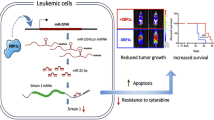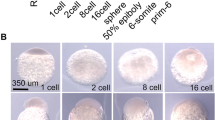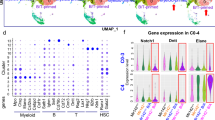Abstract
miR-142 and miR-223 have been identified as hematopoietic specific microRNAs. miR-223 has crucial functions in myeloid lineage development. However, the function of miR-142 remains unclear. In this study, we found that both miR-142 and miR-223 attenuated the proliferation of hematopoietic cells, and that miR-223 up-regulated miR-142 expression through the LMO2-L/-S isoforms and CEBP-β. miR-223 negatively regulated both LMO2-L/-S isoforms and CEBP-β post-transcriptionally, while CEBP-β positively regulated the LMO2-L/-S isoforms and both of the LMO2-L/-S isoforms negatively regulated miR-142. These results reveal a novel miR-223—CEBP-β—LMO2—miR-142 regulatory pathway, which has pivotal functions in hematopoiesis.
Similar content being viewed by others
Log in or create a free account to read this content
Gain free access to this article, as well as selected content from this journal and more on nature.com
or
References
Yu J, Wang F, Yang GH, et al. Human microRNA clusters: Genomic organization and expression profile in leukemia cell lines. Biochem Biophys Res Commun 2006; 349:59–68.
Lee Y, Kim M, Han J, et al. MicroRNA genes are transcribed by RNA polymerase II. EMBO J 2004; 23:4051–4060.
Cai X, Hagedorn CH, Cullen BR . Human micro-RNAs are processed from capped, polyadenylated transcripts that can also function as mRNAs. RNA 2004; 10:1957–1966.
Lee Y, Ahn C, Han J, et al. The nuclear RNase III Drosha initiates microRNA processing. Nature 2003; 425:415–419.
Denli AM, Tops BB, Plasterk RH, Ketting RF, Hannon GJ . Processing of primary microRNAs by the Microprocessor complex. Nature 2004; 432:231–235.
Lund E, Guttinger S, Calado A, Dahlberg JE, Kutay U . Nuclear export of microRNA precursors. Science 2004; 303:95–98.
Yi R, Qin Y, Macara IG, Cullen BR . Exportin-5 mediates the nuclear export of pre-microRNAs and short hairpin RNAs. Genes Dev 2003; 17:3011–3016.
Grishok A, Pasquinelli AE, Conte D, et al. Genes and mechanisms related to RNA interference regulate expression of the small temporal RNAs that control C. elegans developmental timing. Cell 2001; 106:23–34.
Hutvagner G, McLachlan J, Pasquinelli AE, Balint E, Tuschl T, Zamore PD . A cellular function for the RNA-interference enzyme Dicer in the maturation of the let-7 small temporal RNA. Science 2001; 293:834–838.
Doench JG, Sharp PA . Specificity of microRNA target selection in translational repression. Genes Dev 2004; 18:504–511.
Shivdasani RA . MicroRNAs: regulators of gene expression and cell differentiation. Blood 2006; 108:3646–3653.
Chen CZ, Li L, Lodish HF, Bartel DP . MicroRNAs modulate hematopoietic lineage differentiation. Science 2004; 303:83–86.
Fazi F, Rosa A, Fatica A, et al. A minicircuitry comprised of microRNA-223 and transcription factors NFI-A and C/EBPalpha regulates human granulopoiesis. Cell 2005; 123:819–831.
Fazi F, Racanicchi S, Zardo G, et al. Epigenetic silencing of the myelopoiesis regulator microRNA-223 by the AML1/ETO oncoprotein. Cancer Cell 2007; 12:457–466.
Johnnidis JB, Harris MH, Wheeler RT, et al. Regulation of progenitor cell proliferation and granulocyte function by microRNA-223. Nature 2008; 451:1125–1129.
Yuan JY, Wang F, Yu J, Yang GH, Liu XL, Zhang JW . MicroRNA-223 reversibly regulates erythroid and megakaryocytic differentiation of K562 cells. J Cell Mol Med 2008; 13:4551–4559.
Fukao T, Fukuda Y, Kiga K, et al. An evolutionarily conserved mechanism for microRNA-223 expression revealed by microRNA gene profiling. Cell 2007; 129:617–631.
Lekstrom-Himes J, Xanthopoulos KG . Biological role of the CCAAT/enhancer-binding protein family of transcription factors. J Biol Chem 1998; 273:28545–28548.
Xie H, Ye M, Feng R, Graf T . Stepwise reprogramming of B cells into macrophages. Cell 2004; 117:663–676.
Laiosa CV, Stadtfeld M, Xie H, Andres-Aguayo L, Graf T . Reprogramming of committed T cell progenitors to macrophages and dendritic cells by C/EBPa and PU.1 transcription factors. Immunity 2006; 25:731–744.
Royer-Pokora B, Loos Uschi, Ludwig WD, et al. TTG-2 a new gene encoding a cysteine-rich protein with LIM motif, is overexpressed in acute T-cell leukaemia with the t(11;14)(p13;q11). Oncogene 1991; 6:1887–1893.
Aplan PD, Lombardi DP, Reaman GH, Sather HN, Hammond GD, Kirsch IR . Involvement of the putative hematopoietic transcription factor SCL in T-cell acute lymphoblastic leukemia. Blood 1992; 79:1327–1333.
Ferrando AA, Neuberg DS, Staunton J, et al. Gene expression signatures define novel oncogenic pathways in T cell acute lymphoblastic leukemia. Cancer Cell 2002; 1:75–87.
Ferrando AA, Herblot S, Palomero T, et al. Biallelic transcriptional activation of oncogenic transcription factors in T-cell acute lymphoblastic leukemia. Blood 2004; 103:1909–1911.
Pike-Overzet K, de Ridder D, Weerkamp F, et al. Ectopic retroviral expression of LMO2, but not IL2Rc, blocks human T-cell development. Leukemia 2007; 21:754–763.
Yamada Y, Warren AJ, Dobson C, et al. The T cell leukemia LIM protein Lmo2 is necessary for adult mouse hematopoiesis. Proc Natl Acad Sci USA 1998; 95:3890–3895.
Yamada Y, Pannell R, Forster A, et al. The oncogenic LIM-only transcription factor Lmo2 regulates angiogenesis but not vasculogenesis in mice. Proc Natl Acad Sci USA 2000; 97:320–324.
Warren AJ, Colledge WH, Carlton MB, et al. The oncogenic cysteine-rich LIM domain protein rbtn2 is essential for erythroid development. Cell 1994; 78:45–57.
Larson RC, Fisch P, Larson TA, et al. T cell tumours with disparate phenotype in mice transgenic for Rbtn-2. Oncogene 1994; 9:3675–3681.
Hacein-Bey-Abina S, Von Kalle C, Schmidt M, et al. LMO2-associated clonal T cell proliferation in two patients after gene therapy for SCID-X1. Science 2003; 302:415–419.
McCormack MP, Forster A, Drynan L, Pannell R, Rabbitts TH . The LMO2 T-cell oncogene is activated via chromosomal translocations or retroviral insertion during gene therapy but has no mandatory role in normal T-cell development. Mol Cell Biol 2003; 23:9003–9013.
Royer-Pokora B, Rogers M, Zhu TH, et al. the TTG-2/RBTN-2 T cell oncogene encodes two alternative transcripts form two promoter: the distal promoter is removed by most 11p13 translocations in acute T cell leukemia's (T-ALL). Oncogene 1995; 10:1353–1360.
Zhu T, Qin G, Royer-Pokora B . A novel post-transcriptional splicing form of the acute T cell leukemia proto-oncogene Lmo2. Sci China C Life Sci 2001; 44:561–569.
Hammond SM, Crable SC, Anderson KP . Negative regulatory elements are present in the human LMO2 oncogene and may contribute to its expression in leukemia. Leuk Res 2005; 29:89–97.
Landry JR, Kinston S, Knezevic K, Donaldson IJ, Green AR, Göttgens B . Fli1, Elf1, and Ets1 regulate the proximal promoter of the LMO2 gene in endothelial cells. Blood 2005; 106:2680–2687.
Wang Q, Zhang M, Wang X, et al. A novel transcript of the LMO2 gene, LMO2-c, is regulated by GATA-1 and PU.1 and encodes an antagonist of LMO2. Leukemia 2007; 21:1015–1025.
Wadman I A, Osada H, Grutz G, et al. The LIM-only protein Lmo2 is a bridging molecule assembling an erythroid, DNA-binding complex which includes the TAL1, E47, GATA-1 and Ldb1/NLI proteins. EMBO J 1997; 16:3145–3157.
Nam CH, Rabbitts TH . The role of LMO2 in development and in T cell leukemia after chromosomal translocation or retroviral insertion. Mol Ther 2006; 13:15–25.
Yuan W, Sun W, Yang S, et al. Down-regulation of microRNA-142 by proto-oncogene LMO2 and its co-factors. Leukemia 2008; 22:1067–1071.
Felli N, Fontana L, Pelosi E, et al. MicroRNAs 221 and 222 inhibit normal erythropoiesis and erythroleukemic cell growth via kit receptor down-modulation. Proc Natl Acad Sci USA 2005; 102:18081–18086.
Garzon R, Pichiorri F, Palumbo T, et al. MicroRNA fingerprints during human megakaryocytopoiesis. Proc Natl Acad Sci USA 2006; 103:5078–5083.
Karginov FV, Conaco C, Xuan Z, et al. A biochemical approach to identifying microRNA targets. Proc Natl Acad Sci USA 2007; 104:19291–19296.
Ramkissoon SH, Mainwaring LA, Ogasawara Y, et al. Hematopoietic-specific microRNA expression in human cells. Leuk Res 2006; 30:643–647.
Acknowledgements
This work was supported by the National Natural Science Foundation of China (Grant No. 30771054).
Author information
Authors and Affiliations
Corresponding author
Additional information
( Supplementary information is linked to the online version of the paper on the Cell Research website.)
Supplementary information
Supplementary information, Table S1
Mutation primers (PDF 47 kb)
Supplementary information, Table S2
Real-time PCR detection primers (PDF 8 kb)
Supplementary information, Table S3
Cloning primers (PDF 13 kb)
Supplementary information, Table S4
ChIP primers (PDF 8 kb)
Supplementary information, Table S5
5′ RACE antisense primers (PDF 8 kb)
Rights and permissions
About this article
Cite this article
Sun, W., Shen, W., Yang, S. et al. miR-223 and miR-142 attenuate hematopoietic cell proliferation, and miR-223 positively regulates miR-142 through LMO2 isoforms and CEBP-β. Cell Res 20, 1158–1169 (2010). https://doi.org/10.1038/cr.2010.134
Received:
Revised:
Accepted:
Published:
Issue date:
DOI: https://doi.org/10.1038/cr.2010.134
Keywords
This article is cited by
-
microRNA-223 and microRNA-126 are clinical indicators for predicting the plaque stability in carotid atherosclerosis patients
Journal of Human Hypertension (2022)
-
Serum a proliferation-inducing ligand and MicroRNA-223 are associated with rheumatoid arthritis: diagnostic and prognostic implications
Molecular Medicine (2020)
-
Characterization of Holstein and Normande whole milk miRNomes highlights breed specificities
Scientific Reports (2019)
-
IL-27 receptor-regulated stress myelopoiesis drives abdominal aortic aneurysm development
Nature Communications (2019)
-
Role of miR-223 in the pathophysiology of liver diseases
Experimental & Molecular Medicine (2018)



